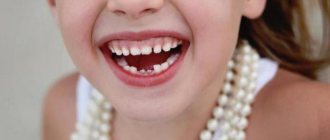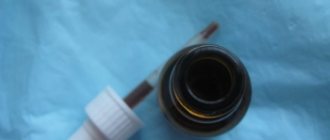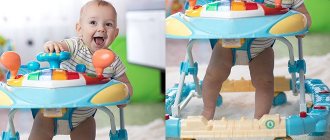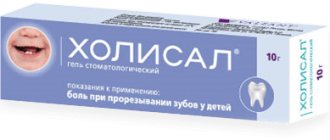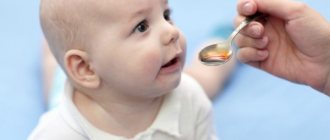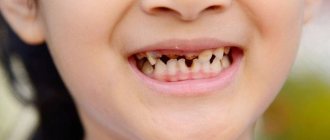1154
The loss of baby teeth is a mandatory stage that occurs in all young children. Theoretically, this process is tied to certain deadlines.
But sometimes they do not coincide with the actual time of the event. In addition, when a child falls out, additional problems arise that make parents worry.
How do temporary teeth change?
It is a well-known fact that the normal number of teeth for an adult is 32. Why do children only have 20? The fact is that at 6 months, when the baby’s first teeth begin to erupt, his jaw is very small. As the child grows, it lengthens. And during the change period, two additional pairs of teeth appear on each jaw. They are called premolars and are located between the canines and molars. As a result, the number of teeth increases from 20 to 28. Where are the other 4? These are the so-called wisdom teeth, and they will grow much later, after 17 years.
The process of changing teeth is mostly painless. It turns out that temporary incisors, canines and molars have roots that dissolve over a certain period. As a result, baby teeth lose support, become loose and fall out one after another. They are replaced by molars, which have a denser structure, hard enamel and have greater endurance compared to temporary teeth. This is how a child’s body adapts to adult food. The order of loss of baby teeth in children, the diagram and timing of this process will be given below.
Why is this happening?
Before considering the timing and possible problems, let’s look at the cause of loss of primary teeth. The formation of primordia occurs during intrauterine development .
After birth, temporary teeth begin their active growth and erupt. Over time, the development of the rudiments of permanent teeth occurs. This leads to resorption of the tissues of the root of the mammary crown, which gradually reaches the cervix.
As a result of the formation of a shortened root or its complete absence, the crown becomes loose and falls out. The degree of root resorption can be determined by the intensity of crown loosening.
The first signs of changing temporary teeth
Thanks to some signs, you can determine that a child will soon begin the process of losing baby teeth:
- The spaces between the teeth increase. Due to the lengthening of the growing jaw, temporary incisors, canines and molars find themselves at an increasing distance from each other. The reason to visit the dentist is that the child is already six years old, but the gaps have remained unchanged. To guide parents in terms of timing, a special scheme has been developed for the loss of baby teeth in children. The age and sequence of replacement are described there.
- Loose baby teeth. About two years before the temporary incisors, canines and molars begin to fall out, their roots begin to dissolve. As this process moves to the neck of the tooth, the latter gradually begins to wobble.
- Eruption of a permanent tooth next to the milk tooth. Sometimes it happens that a temporary incisor, canine or molar has not yet fallen out, but its root heir can already be seen nearby. Dentists consider this phenomenon harmless. And yet, in the case when a permanent tooth has erupted, but the milk tooth located next to it has not fallen out within three months, you should consult a dentist.
Possible related problems
Some children begin to lose teeth before the age of 4, others only at school age. A serious deviation in timing should worry parents, since often this phenomenon can have pathological causes and lead to dental problems.
Non-compliance with shedding period standards can be caused by a number of factors:
- unbalanced diet;
- poor chemical composition of water;
- genetic predisposition;
- untimely development of rudiments or their complete absence.
Drop out ahead of schedule
Premature loss of temporary teeth is one of the common problems that can lead to curvature of the entire row . Baby teeth are an indicator for permanent crowns, therefore, if they fall out ahead of the standard time frame, the permanent crowns may erupt, taking on the wrong position .
Typically, crowns grow in a rotated position relative to the main row. It is also possible for the crown to grow sideways through the gum. In the latter case, this may be accompanied by pain.
To prevent the appearance of a defect in the early loss of a baby tooth, you need to consult a dentist. He will install a special spacer - a holder - .
It will ensure that space is preserved for the eruption and proper growth of a new tooth. The spacer is made of thin metal wire that does not cause discomfort to the child. When a new tooth appears in the gum tissue, the holder is removed.
The most common causes of premature loss are:
- abnormal bite;
- excessive pressure from adjacent crowns;
- developing tumor;
- removal of forced nature.
We'll tell you how to stop bleeding after tooth extraction. Time-tested techniques.
Let's talk here about the causes and treatment of cracked tongue.
Follow the link: https://zubovv.ru/lechenie/zubyi/emal/na-zubah-belyie-pyatna-etiologiya-i-terapiya.html - read how to get rid of white spots on teeth.
Drop out later than expected
All dentists are of the same opinion that late loss of baby teeth is much better than early loss . This phenomenon can occur for the following reasons:
- heredity;
- transmission of an infectious disease in severe form;
- chronic dyspepsia;
- rickets suffered in infancy;
- phenylketonuria.
In this case, the milk supply still begins to thin out by the age of 8. If this process has not begun by this age, then one can suspect that the permanent rudiments are located too deep or their complete absence .
Shark teeth
The main stage of splitting the root tissue of primary crowns and pushing them out of the gum pocket sometimes fails. It causes permanent teeth to erupt faster than temporary teeth fall out .
This phenomenon can manifest itself not only on individual crowns, but also spread to the entire dentition. As a result, the two rows have a parallel arrangement of teeth relative to each other. This phenomenon does not cause serious complications.
After some period, the temporary crowns still fall out, and the permanent ones, gradually moving, take their place.
If the process has dragged on for more than 3 months, and the permanent teeth have difficulty moving into the correct position, then it is necessary to seek the help of a dentist. Most often, corrective orthodontic structures are used to solve the problem: mouth guards, braces.
Pain and fever
Losing baby teeth is often accompanied by discomfort. The gum, which fits tightly to the neck of the crown, comes off as the tooth loosens, causing pain .
The most pronounced pain syndrome is observed with the loss of molars and premolars. This process may be accompanied by swelling of the damaged gum and even an increase in temperature up to 38 ° C. It should be borne in mind that the younger the age, the more intense such manifestations are.
The severe course of this process leads to a high load on the nervous system, rapid fatigue, and overexcitation in the evening. In children over 7 years of age, the listed symptoms are isolated and smoothed out.
Problems that arise at the stage of changing teeth rarely have pathological causes and, with proper correction by the dentist, are quickly eliminated.
Timing and order of loss of temporary teeth
Let's see how baby teeth are replaced by molars in children: at what age do they fall out? What is the replacement scheme? And how long does this process take? Experts say that the timing is individual for each child. The total duration of replacement of incisors, molars and canines is six to eight years. On average, the onset of hair loss in girls is six years of age, and in boys a little later. However, modern children are developing rapidly. Therefore, the pattern of loss of baby teeth in children can also be tied to the age of five. Also, the start date of the process of changing incisors, molars and canines and its duration depend on the genetic heredity of the child. The influence of climatic conditions, dietary habits and quality of drinking water is affected.
Below is a graphical representation of the sequence in which molars are replaced in children. The prolapse diagram, a photo of which is attached, shows that the incisors are replaced first, then the first molars, then the turn of the canines comes, and the last on the list are the second molars.
At six or seven years of age, when the process of changing “milk jugs” begins, the central incisors are the first to fall out. Moreover, first this happens to the teeth of the lower jaw (they are represented in the figure as number 1), and after them comes the turn of the upper teeth (number 2).
Next, the lateral incisors located on the upper jaw (number 3 in the image) fall out, followed by the same lower teeth (number 4). Their change occurs when the child turns seven or eight years old.
Then the pattern of loss of baby teeth in children involves the replacement of the first molars of the upper and lower jaws (shown in the figure as numbers 5 and 6). This occurs between the ages of nine and eleven years.
At the next nine to twelve years, according to the norm, the fangs of the upper jaw (number 7 in the image) should fall out, and after that the same teeth from below (shown as number 8).
Last, as evidenced by the pattern of loss of baby teeth in children, comes the second molars of the lower jaw (number 9 in the figure), and then the upper ones (number 10). This happens at ten to twelve years of age.
What time do baby teeth fall out?
By the age of three, a child has 20 milk teeth: 10 on the bottom and the same number on top. Now the baby is the happy owner of eight molars, four canines, four lateral and four central incisors. When does the time come for the first tooth to fall out? As a rule, teeth begin to fall out in pairs, with the first from the lower jaw. The incisors will fall out first, followed by the canines, and finally the molars.
- From five to six years of age, the child’s central incisors fall out.
- From seven to eight years - lateral incisors.
- From nine to twelve years old - fangs.
- From ten to eleven years - the first molars.
- From eleven to thirteen years - second molars.
But remember that these are all guidelines. Any baby can have deviations from these indicators, and at the same time they will still be considered a variant of the norm.
Why is it important to preserve primary teeth?
Baby teeth are more susceptible to the negative effects of caries than molars. And complications of this disease occur quite often. The child himself cannot realize that his tooth enamel is damaged. That is, to diagnose caries, a visit to the dentist is necessary. Parents should take this very seriously. After all, advanced diseases of baby teeth are a direct path to their loss, which in itself is a bad factor.
Temporary incisors, canines and molars are the “guardians” of space for their original replacements. If a temporary tooth is lost, its neighbors begin to move to fill the resulting void. Afterwards, the indigenous followers, who will grow in the place of the existing milk plants, will not have enough space for normal development, and they will creep on top of each other, forming an uneven row. It is also possible to disrupt their growth, shift to the side and form an incorrect bite.
Functions of anterior teeth
Like all organs and systems of the human body, teeth have their own function. The front teeth are the incisors, which include the central and lateral teeth (ones, twos, threes and fours). The main functions of the front teeth:
- Digestive . The front teeth are designed to grab and bite a certain portion of food and move it into the oral cavity.
- Formative . The correct placement of a child’s incisors, starting from the teething stage, becomes the basis for a correct bite.
- Aesthetic . An attractive, beautiful smile that beautifies a person is possible only if you have healthy, straight front teeth.
- Articulatory . The nature of sound pronunciation greatly depends on the correct bite. The front teeth are involved in the pronunciation of many consonant sounds.
As can be seen from the above, the front teeth serve many functions. Therefore it is important that they are healthy. But often a child’s front teeth have some defects and are susceptible to various diseases.
Removal of a baby tooth at the dentist: possible reasons
A good pediatric dentist will never allow a baby tooth to be removed if it can be treated and saved. However, there are situations when this cannot be avoided. Removal of a temporary tooth is justified in the following cases:
- Severe destruction of the “milk jug” and the impossibility of its restoration.
- Presence of a basal cyst of a temporary tooth.
- The development of inflammation, which can subsequently lead to problems with the molar.
- Eruption of a permanent tooth when the baby tooth has not fallen out.
- Severe wobbling of a primary incisor, canine or molar, which causes pain and discomfort to the child.
Premature loss of primary teeth
Above, the age range at which baby teeth are replaced in children and the pattern of loss were determined. 5 years is the time limit after which the loss of an incisor, canine or molar is no longer considered premature, despite the fact that the norm for starting the replacement of temporary teeth in pediatric dentistry is when a child reaches the age of six.
The reasons for premature loss of milk jugs may be as follows:
- Injury. The child lost a tooth as a result of mechanical impact (fall, blow).
- An abnormal bite, which in pediatric dentistry is designated by the term “deep.” The upper jaw covers the lower jaw, the teeth of which are subjected to excessive pressure, and there is a possibility of losing them.
- Pressure of neighboring teeth. This happens when the milk jugs have not grown properly. The reason for premature loss is similar to the previous point - excessive pressure on a temporary incisor, canine or molar.
- Caries in advanced condition. In this case, the baby tooth simply crumbles.
- Intentional loosening of a temporary incisor, canine or molar by a child.
The tooth has fallen out and is bleeding
Blood after a baby tooth falls out
Parents should be prepared for the fact that when a baby tooth falls out, the child’s gums will bleed. This is normal. It is important that parents know how to behave in such a situation. Sometimes the blood clots quickly enough, the wound heals, and the baby doesn’t even notice that something has happened.
What can parents do:
- The first thing you can do, and often this is enough, is to give the child a piece of cotton wool. Let him apply it to the site of the lost tooth.
- You may be advised to rinse your mouth with peroxide, as it has a disinfecting effect. However, it will not have the desired effect and will act irritatingly on the wound.
- The most effective way to stop bleeding and relieve inflammation is to rinse the mouth with a soda solution.
- It should not be ruled out that, although in rare cases, you may not be able to stop the bleeding. Only in this case should you not delay going to the doctor. Perhaps the baby’s clotting process is impaired or there is some factor that prevents this from happening.
- There are cases where a child could accidentally swallow a lost tooth. That is, the loss happened so unnoticed. If the child does not complain of feeling unwell, the tooth will come out naturally. But it is still recommended to visit a doctor to make sure that the tooth has fallen out completely and that there is no remainder sticking out in the gum.
We suggest you read: A tooth has fallen off but the root remains, what to do?
Delayed loss of primary teeth
There is a situation when milk teeth are in no hurry to fall out. The reason for this may be the child’s heredity, a history of severe infectious disease, rickets in the child, or an unbalanced diet and, as a result, a lack of vitamins and calcium in the body.
It is possible that the baby tooth has not yet fallen out, but its permanent replacement is already beginning to erupt next to it. This is called "shark teeth". There is nothing terrible, but only in the case when within three months the “milk jug” still gives way to a permanent tooth. Otherwise, a visit to the dentist is necessary.
Also, a trip to the dentist is necessary if the child is already eight years old and his baby teeth are still in place.
What to do when a child’s baby tooth falls out?
If the baby is scared, calm him down and caress him. And explain in a way that is understandable to him that this is normal, he is growing, he will soon grow a new and beautiful tooth in this place, etc. Just don’t touch the wound with your tongue or hands to avoid infection.
If the wound is bleeding, place a sterile piece of bandage on the wound and let him bite it. When the bleeding stops, and this happens very quickly after 2-3 minutes, remove the bandage. If the wound continues to bleed, take your child to the pediatric dentist.
If everything is fine, try not to feed your child for 2 hours. On this day and at least the next. Try to reconsider the diet, give your baby only: porridge, soup, dairy. Nothing: hot, spicy, salty, you need to give the wound time to heal.
Sometimes children develop a fever. If it is small and the baby is cheerful and plays with pleasure, then there is no need to panic. But if the temperature does not subside, but, on the contrary, rises, then seek help.
Temperature may indicate the onset of an inflammatory process. The fallen tooth does not need to be thrown away; hide it in the box. You can tell your child a fairy tale about a mouse or the Tooth Fairy who come at night and take a tooth and leave sweets in its place.
Take the time to put his favorite candies next to your baby’s crib. Everything needs to be done to ensure that this natural physiological process does not cause negative emotions or fear in your child.
What to do after a temporary tooth falls out
Usually, the loss of a baby tooth is preceded by its loosening, so such a moment will not come as a surprise to the child. After the loss of a temporary canine, incisor or molar, a wound forms at the site where it grew. To stop the bleeding, apply a sterile cotton swab or gauze to the hole. After 3-5 minutes the bleeding will stop.
Within 2 hours after the loss, you should not feed the child, and after this time, you need to take warm food of a homogeneous composition for two to three days. Hard components and large fragments should be excluded to avoid injury to the unprotected area of the gum. After eating, you need to carefully rinse your mouth. The clot of dried blood that forms at the site of tooth loss will fall out on its own within two to three days. Removing it mechanically is strictly prohibited.
What to do? Useful tips for parents
To relieve unpleasant symptoms during the process of hair loss in very young children, doctors recommend using the complex product Dentokind . It eliminates pain, relieves inflammation and stabilizes the functioning of the nervous system.
After losing a tooth, a wound forms. In some cases, slight bleeding may occur . To eliminate it, you need to form a tampon from a sterile bandage and place it over the wound.
The tampon should be bitten slightly and left for 3-5 minutes. As a rule, this time is enough. If the bleeding does not stop after 15 minutes, you should contact your dentist.
As an aseptic treatment, you can rinse the wound with a saline solution with the addition of a few drops of iodine.
In the first two hours, the child should not eat. In case of inflammation and pain of the wound, topical dental preparations can be used.
Solcoseryl paste, Kamistad gel, Kalgel have proven themselves well . It is not recommended to treat the wound with hydrogen peroxide, as it can only harm the child.
What antibiotics are prescribed in dentistry for flux. List of effective drugs.
This article discusses the treatment of geographic tongue in a child.
Here: https://zubovv.ru/lechenie/zubyi/shatayutsya-chto-nuzhno-delat-i-kak-ih-ukrepit.html - we’ll tell you what to do if a molar is loose.
Oral care
If a baby tooth falls out and a wound forms, you should never give up oral hygiene. This will provide additional antibacterial protection to damaged tissues.
But it is worth considering that oral care during this period has its own characteristics :
- cleaning the crowns should be carried out with careful movements, without pressure; for this procedure it is worth purchasing a soft brush, the bristles of which have rounded tips;
- It is best to use a children's paste with an anti-inflammatory effect;
- It is recommended that after each meal you rinse your mouth with water or a special mouthwash intended for children;
- if inflammation occurs and the wound does not heal for a long time, you must consult a dentist;
- there is also no need to neglect regular dental examinations;
- if the crowns are affected by caries, treatment must be carried out. As a preventive measure, have your dentist do a fissure sealant.
Features of child nutrition
During the period of temporary teeth falling out, not only care, but also the child’s diet requires special attention. The nutritional features in this case are as follows:
- Immediately on the day of crown loss, you should not eat irritating foods . Avoid hot, salty, spicy foods and dishes. They can cause additional irritation of the wound, causing discomfort to the child.
- Since the loss of teeth is often accompanied by the appearance of new ones, for their full development and healthy growth it is necessary to provide the body with a complex of microelements and vitamins. The most significant role for this time is played by calcium . Introduce more dairy products into your child’s diet: cottage cheese, milk, cheese.
- To ensure complete absorption of calcium, it is worth including foods containing vitamin D : seafood, eggs, sour cream, liver.
- If you refuse such products, it is recommended to take multivitamins or mineral complexes .
- Increase your consumption of vegetables and fruits .
- To stimulate active root resorption, give your child more solid foods. But in the first few days after tooth loss, you should avoid consuming such products so as not to further injure the wound.
- It is also worth excluding various sweets from your diet . They create a favorable environment for the proliferation of bacteria that cause inflammation and caries.
The process of baby teeth falling out is purely individual. For some, it occurs promptly and painlessly. Others may run into problems. The dentist will help solve them by identifying and eliminating the cause.
In conclusion, a video about changing baby teeth:
If you find an error, please select a piece of text and press Ctrl+Enter.
Tags: loss of baby teeth children baby teeth
Did you like the article? stay tuned
What not to do after a temporary tooth falls out
After the milk jug falls out, you should not let your child chew on very hard foods, such as nuts, crackers, and caramel. It is also prohibited to use antiseptics (hydrogen peroxide or alcohol solutions) to cauterize the resulting wound. Do not touch the bleeding hole with your fingers to prevent infection.
If, after the loss of a temporary incisor, canine or molar, a child has a fever, this is a reason to immediately contact a pediatrician. And during the period of changing baby teeth, you should contact the dentist at least twice a year for a preventive examination.
Caring for your teeth during their replacement period
To keep baby teeth intact and healthy, the following is recommended:
- Brush your teeth using a soft brush twice a day.
- Get your baby used to rinsing his mouth every time he eats.
- Include dairy and fermented milk products in your child’s diet to enrich the body with calcium.
During the period of change of temporary incisors, canines and molars in a baby, adults ask the following questions: when do molars begin to replace baby teeth in children? Dropout pattern? And how long does this process take? The answers to them are in this article. The main thing for parents is to remember that they need to visit the pediatric dentist twice a year for a preventive examination in order to timely identify problems, if any. This will keep your baby's teeth beautiful and healthy.
Nutrition specifics
- The presence of foods high in calcium is a must. Particular attention should be paid to cottage cheese.
- It is mandatory to consume fish products twice a week to provide the body with phosphorus in full. It is advisable to feed your baby low-fat varieties of fish, for example, hake or pollock.
- It is important that the child actively eats fruits and vegetables. There should also be types of durum varieties.
- Avoid excessive consumption of sweets. Sodas will cause particular harm.
- If the child does not like dairy products or has lactose intolerance, medications containing calcium may be prescribed.
- It is advisable to avoid nuts and sticky sweets. They can disrupt the structure of a baby tooth and affect earlier loss or deformation of the tooth surface.
- Avoid products that contain active dyes. You can ruin the color of the enamel for many years, or even for life.

